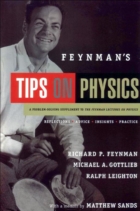By Richard P Feynman, Michael A Gottlieb and Ralph Leighton
Basic Books
Paperback: £11.99 $16.99

Originally published in hardback not long ago (Addison Wesley 2006), Feynman’s Tips on Physics is now available as a slim paperback, complete with some additional material. It is essentially a collection of four “lost” lectures and could be thought of as four chapters that somehow didn’t make it into The Feynman Lectures on Physics – the well known three-volume set by Feynman and colleagues Robert Leighton and Matthew Sands. To complement these, Michael A Gottlieb and Ralph Leighton (Robert’s son) have added a fifth chapter with selected problems from Exercises in Introductory Physics by Leighton Sr and Rochus Vogt. To set the scene, they also include a “memoir” by Sands on the origins of the famous three books in their distinctive red covers and – new for this edition – three interviews, with Leighton Sr, Vogt and Feynman himself.
The first thing to say is that the scientific level of the four lectures is far below that of the other published lectures. The first lecture, “Prerequisites”, is an elementary reminder about the importance of learning basic calculus and vector algebra and it is unlikely that anyone reading this review will find anything new. Perhaps the main point of interest is Feynman’s discussion on how to deal with not being the top member of a group comprised of many talented people. This might provide some inspiration to bright high-school students who go from being top of their class to no longer being at the top at a good university.
The second lecture, “Laws and Intuition” attempts to explain to students the importance of having a feel for the material and using physical intuition to back up mathematical calculations. This could help students, who far too often, in my experience, just want to know “what formula to use”.
“Problems and Solutions”, the third lecture, is pitched at a slightly more advanced level. It would be suitable for a good high school student or first-year university student and covers a range of interesting topics from satellite motion to rockets (including ion and photon propulsion) as well as a couple of simple particle-physics examples: electrostatic deflection of a proton beam and the determination of the charged-pion mass.
Last, “Dynamical Effects and Their Applications”, is essentially about gyroscopes. It contains little mathematics and the technology is quite dated but it is fun to read. In fact, even the datedness of some of the material has its charm. Feynman says: “Computing is mostly analogue at the moment, but it is likely that it’ll turn into digital – in a year or two, probably – because that has no errors in it.” How things have changed since 1962!
While there is not much here for the practising physicist, it is a quick and easy read and contains many interesting things about the history of The Feynman Lectures in Physics in the introduction (and the surprising statement that there are more than 170 errors in the 3 volume set). As such, it is worth the hour or two that it will take to read – and, after all, it is Feynman. While it is unlikely to find much use as a reference work, it would make a nice gift for someone about to start studying physics – but together with the full 3-volume set.





